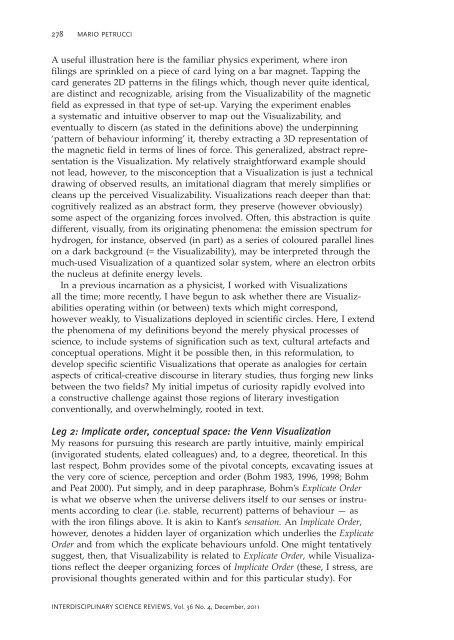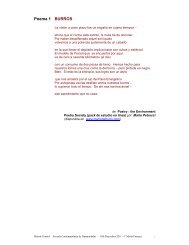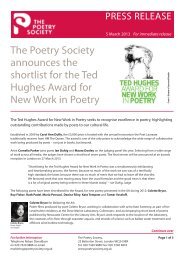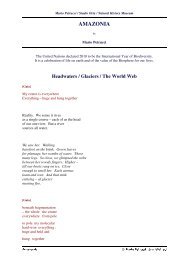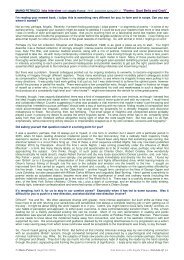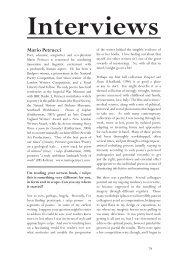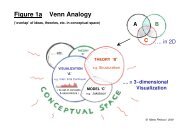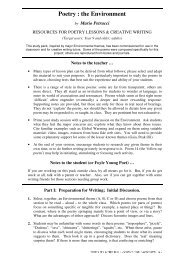Scientific Visualizations: Bridge-Building between ... - Mario Petrucci
Scientific Visualizations: Bridge-Building between ... - Mario Petrucci
Scientific Visualizations: Bridge-Building between ... - Mario Petrucci
Create successful ePaper yourself
Turn your PDF publications into a flip-book with our unique Google optimized e-Paper software.
278 MARIO PETRUCCI<br />
A useful illustration here is the familiar physics experiment, where iron<br />
filings are sprinkled on a piece of card lying on a bar magnet. Tapping the<br />
card generates 2D patterns in the filings which, though never quite identical,<br />
are distinct and recognizable, arising from the Visualizability of the magnetic<br />
field as expressed in that type of set-up. Varying the experiment enables<br />
a systematic and intuitive observer to map out the Visualizability, and<br />
eventually to discern (as stated in the definitions above) the underpinning<br />
‘pattern of behaviour informing’ it, thereby extracting a 3D representation of<br />
the magnetic field in terms of lines of force. This generalized, abstract representation<br />
is the Visualization. My relatively straightforward example should<br />
not lead, however, to the misconception that a Visualization is just a technical<br />
drawing of observed results, an imitational diagram that merely simplifies or<br />
cleans up the perceived Visualizability. <strong>Visualizations</strong> reach deeper than that:<br />
cognitively realized as an abstract form, they preserve (however obviously)<br />
some aspect of the organizing forces involved. Often, this abstraction is quite<br />
different, visually, from its originating phenomena: the emission spectrum for<br />
hydrogen, for instance, observed (in part) as a series of coloured parallel lines<br />
on a dark background (= the Visualizability), may be interpreted through the<br />
much-used Visualization of a quantized solar system, where an electron orbits<br />
the nucleus at definite energy levels.<br />
In a previous incarnation as a physicist, I worked with <strong>Visualizations</strong><br />
all the time; more recently, I have begun to ask whether there are Visualizabilities<br />
operating within (or <strong>between</strong>) texts which might correspond,<br />
however weakly, to <strong>Visualizations</strong> deployed in scientific circles. Here, I extend<br />
the phenomena of my definitions beyond the merely physical processes of<br />
science, to include systems of signification such as text, cultural artefacts and<br />
conceptual operations. Might it be possible then, in this reformulation, to<br />
develop specific scientific <strong>Visualizations</strong> that operate as analogies for certain<br />
aspects of critical-creative discourse in literary studies, thus forging new links<br />
<strong>between</strong> the two fields? My initial impetus of curiosity rapidly evolved into<br />
a constructive challenge against those regions of literary investigation<br />
conventionally, and overwhelmingly, rooted in text.<br />
Leg 2: Implicate order, conceptual space: the Venn Visualization<br />
My reasons for pursuing this research are partly intuitive, mainly empirical<br />
(invigorated students, elated colleagues) and, to a degree, theoretical. In this<br />
last respect, Bohm provides some of the pivotal concepts, excavating issues at<br />
the very core of science, perception and order (Bohm 1983, 1996, 1998; Bohm<br />
and Peat 2000). Put simply, and in deep paraphrase, Bohm’s Explicate Order<br />
is what we observe when the universe delivers itself to our senses or instruments<br />
according to clear (i.e. stable, recurrent) patterns of behaviour — as<br />
with the iron filings above. It is akin to Kant’s sensation. An Implicate Order,<br />
however, denotes a hidden layer of organization which underlies the Explicate<br />
Order and from which the explicate behaviours unfold. One might tentatively<br />
suggest, then, that Visualizability is related to Explicate Order, while <strong>Visualizations</strong><br />
reflect the deeper organizing forces of Implicate Order (these, I stress, are<br />
provisional thoughts generated within and for this particular study). For<br />
INTERDISCIPLINARY SCIENCE REVIEWS, Vol. 36 No. 4, December, 2011


